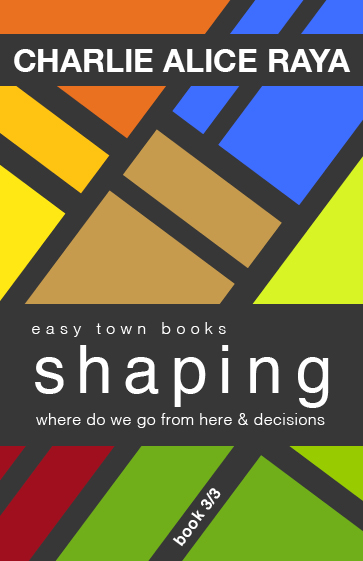Two dot.simulations and dot.profits
Extract from book 3/3, shaping, by Charlie Alice Raya

The idea for dot. was developed in book 1, beginning, and has since become a regular feature in the easy town books.
The following is an extract from the third part of book 3, shaping.
‘Back in September, we talked about a simulation which could compare the effects of different business models. The idea was to pick an industry and then have one simulation run a business the way that is still common: profit oriented and competitive. And another business with one of our business models. In the course of this discussion, we decided to postpone this idea. But I was curious and built a simulation for the clothing industry. Company A uses present business practices and dot. uses our dot.business model. In order to measure and compare the outcomes of both models, I included all parameters used by business analyst, and I added parameters like durability, material effects, waste creation for all stages from material sourcing to the disposal of the products by the customer, health benefits, cycles usage, recycling scale, empowerment scale, product variety, diversity, mental health, connections, synergies, collaborations, sustainability, ripple effects and many more. The results are truly remarkable. Our dot.model is superior in every single category, even with regard to profits before redistribution. Profits are higher because our customers recognise that we work for their benefit, that all our products are high quality and durable, that we don’t exploit, neither people nor nature, that we only produce what the customer actually wants and needs. Profits are also higher because we rarely cause harm to the health of anyone who works for dot. We hardly get any sick days or accidents, talents and creativity are unearthed which leads to more satisfaction, confidence and a robust mental health. There are more requests for training which contributes to a highly skilled, active and engaged team. In addition, dot. rarely causes harm to the environment or to local communities. Profits are also higher because we save tremendous amounts of money by spending little or nothing on advertising, transport, waste disposal, landfills, chemicals, plastic, fossil fuels or other crude oil products, lobbying or other bribes, lawyers or spies. At our larger stations we save additional money by integrating waste and water cycles which also serve the community, and by providing the station and the community with easily affordable electricity. On top of that, we contribute to a healing planet, partly by creating a culture where buying less is more and where recycling is part of the deal, partly by integrating our workshops and stations into nature, partly by actively searching for opportunities to rewild, partly by orienting our production level on low stress levels for the environment. All our measures are exponentiated by having established a network of suppliers for dot. who operate on the same principles. Sustainability and people’s welfare are rising because our suppliers are treated with the same respect everyone at dot. experiences. Additionally, we strengthen local economies by paying good wages, which means increased purchasing power and that companies outside of our network also benefit from our activities because we don’t concentrate all money in our own cycles. In the short time, in which dot. has been operating, it has generated more profit than the sales alone would have made possible, simply by the gains in welfare, both for those who work with dot. and our customers, by abstaining from damaging our habitat, and by unprecedented cost savings. With the Hub and dot. we lay the foundations for companies which integrate into communities and into the natural world in every possible way. Being part of life not life’s vampire. The parameters—’
©Charlie Alice Raya, book 3/3, shaping (last updated: 28 March 2025)
Note
In the scene above I make assumptions, but it’s worth testing whether it is possible to build a company which can achieve just that.
For more about book 3, shaping, visit the easy town books website >
Get in touch
If you would like to join the initial dot.team or a later dot.team, or if you would like to support the project, please, get in touch: contact@dot-international.net

